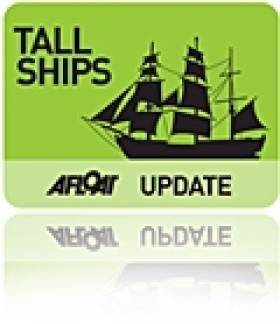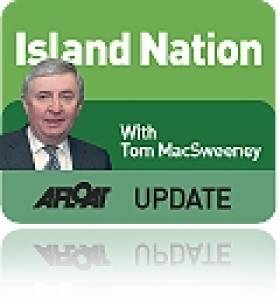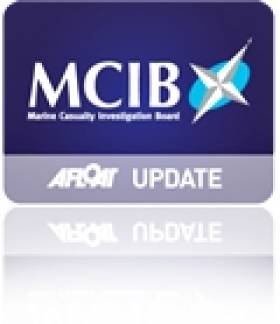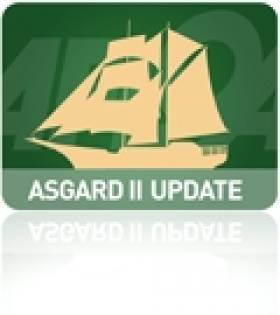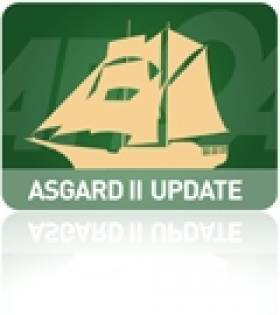Displaying items by tag: Asgard
Tall Ship Interests Plan Replacement for Asgard II
Ireland could yet have a Tall ship to replace the Asgard II and the Lord Rank, if a new sailing group formed to press for a replacement is successful. The news is in this morning's Irish Times newspaper. Groups representating different interests from maritime to tourism to economic are getting together for a special conference on March 26th in Dublin Port. The full Irish Times story is HERE. Next week in Afloat magazine's March/April issue an article called 'Tall Order for Ireland' gives all the details on the conference. It includes a 'call for contributions' from key stakeholders who would support a Tall Ship for Ireland. More details HERE. And in a separate article WM Nixon looks at the realities of national sail training in the 21st Century. This new move on a replacement seems to have entirely appropriate timing; Asgard II was commissioned in Arklow 30 years ago this week, on March 7, 1981.
Looking for further reading on Tall Ships in Ireland? Click the links below:
Click this link to read all our Tall Ships Stories on one handy page
Previewing Ireland's Tall Ships 2011 Season
Can Ireland Get a New Tall Ship?
Now There is None
What a magnificent sight it was as the three Tall Ships, each flying the Tricolour, headed the fleet of the gracious ships of sail from all over the world.
How different it will be in July when the world's Tall Ships again parade down the Suir. There will be no Irish national sailing ship to lead the parade. A number of private Irish entries are expected at Waterford from June 30–July 3 amongst the 70 vessels from around the world when the city has the honour starting the race. In 2005 about half-a-million people visited the city while the Tall Ships were there.
The lack of a national tall ship is another example of governmental maritime neglect, directly due to the decision of former Defence Minister Willie O'Dea, T.D. After the sinking of ASGARD he publicly committed the Government to its replacement, but after receiving insurance compensation money for its loss, he put the money into coffers of the Department of Finance and closed down the national sail training programme. There was a big difference between what he promised and what he did, a disregard for the maritime sphere which it is hard to forgive. I also recall how former Taoiseach Bertie Ahern did not visit Waterford during the 2005 race, when it was the biggest tourist event in the country. When I broadcast my report expressing astonishment at this snub government sources and Fianna Fail didn't like it. Truth in the news can be painful!
The organisers made contacts about the DUNBRODY, which continues to earn income at the New Ross quayside where it is moored as a tourist attraction and with the JEANIE JOHNSTON, moored at the Dublin Docklands.
However, neither will be taking part, the organisers have confirmed, tough they said that it was expected that about 100 young Irish trainees would sail aboard tall ships in the race, half of them with funding support from local authority, business and other sources. A group of Irish sailors have also indicated they are making arrangements to charter a UK-registered vessel the JOHANNA LUCRETIA for the event.
Once again the Irish Government has sunk to the bottom where maritime matters are concerned.
It was announced this week in Waterford that Fáilte Ireland has made a significant financial and marketing commitment to this year's event, though the financial figure was not disclosed .A free festival programme will feature street acts; comedy; international and home-grown artists, nightly fireworks, an artisan food village and an atmosphere which the organisers say "will thrill people of all ages and nationalities."
• This article is reprinted by permission of the EVENING ECHO newspaper, Cork, where Tom MacSweeney writes maritime columns twice weekly. Evening Echo website: www.eecho.ie
Lecture: "Childers and the Asgard"
The Dublin Bay Old Gaffers Association (DBOG) are holding their annual Winter /Spring lecture programme in the Poolbeg Yacht Boat Club & Marina (PYBC). The first lecture in 2011 is "Childers and the Asgard - The Enduring Enigma" by Tim Magennis and is to be held on Tuesday 11 January.
The talks proper will begin at 8 pm but the organisers are encouraging those wishing to attend to assemble at 7.15 pm for a socialable drink in advance of the talk starting.
The Poolbeg clubhouse is located on the South Bank, Pigeon House Road, Ringsend which can be accessed from the Sean Moore Road that connects the Merrion Strand Road (from the south) and the East-Link Toll Bridge (from the north).
For further information on the DBOG lectures please contact Tim Magennis on 087 2593113. For information in general about the PYBC Tel: (01) 668 9983 or logon to www.poolbegmarina.ie/
Report into Asgard II Sinking Due Tomorrow
On 10th September 2008 the STV "Asgard II" departed Dournenez, France bound for La Rochelle, France with 5 crew and 20 trainee crew onboard. At approximately 01:00 hrs GMT on 11th September 2008 when off St. Nazaire in the Bay of Biscay water ingress was observed in the Trainee Mess. At 01:05 hrs a Pan Pan message was broadcast. At about 01:15 hrs a Mayday Relay message was received by French Search and Rescue (French SAR) as the water in the Trainee Mess continued rising rapidly. The crew attempted to pump the flood water without success.
The ship was abandoned by liferaft at approximately 01:50 hrs. Two French lifeboats rescued all 25 persons from the liferafts.
During the abandonment the floor of one of the three liferafts launched failed and the persons onboard were successfully transferred to the other liferafts. No loss of life occurred and there were no injuries reported.
Asgard II Accident Report Due in Two Weeks
The Marine Casualty Investigation Board (MCIB) report of the investigation in to the sinking of Asgard II will be published in the next two weeks, two years after the ship sank off the French coast. The Irish Times has more HERE.
Raise the Asgard - Afloat's 2008 online petitionJeanie Johnston Tall Ship Contract Awarded
The DDDA bought the ship in 2005 for about €2.5m and it has proved a popular static exhibit. A proposal that it be loaned free of charge to the Department of Defence, to replace the Asgard II as a training vessel, was turned down by the department.
Looking for further reading on Tall Ships in Ireland? Click the links below:
Click this link to read all our Tall Ships Stories on one handy page
Previewing Ireland's Tall Ships 2011 Season
Can Ireland Get a New Tall Ship?
Coiste an Asgard Statement
What follows is a press statement from Coiste an Asgard regarding the divers who retrieved items from the wreck of the Asgard II
"The wreck of Asgard II is lying on the sea-bed, 21 miles from the French Island of Belle Ille in the Bay of Biscay, in 83 meters of water.
"Neither the Minister, nor the Board of Coiste an Asgard has granted any person, company or organisation permission to dive on or retrieve any artefacts from the Vessel. If any items have been removed from the Vessel, Coiste an Asgard would expect the items to be returned.
"Due to the condition of the wreck and in particular due to the tangle of masts and rigging at the site and mindful of the depth at which she is lying, the Board feel that any attempt to dive on the wreck represents an unacceptable level of danger to any person involved.
"At the time of the sinking, due to the superb seamanship of the Crew, no loss of life or injury occurred. The Minister and the Board cannot countenance permitting any person being put at risk in or around the wreck of Asgard II. The Board is continuing to monitor the situation with the assistance of the French authorities."
Raise the Asgard - Afloat's 2008 online petition
Asgard Divers Spark Salvage Controversy (w/ Podcast)
A team of divers, including a member of the Garda Siochana, who removed items from the wreck of the Asgard II have become embroiled in a maritime law controversy.
The team faced questioning by French police yesterday and may also have questions asked by the Minister for Defence, Tony Killeen.
Minister for Defence Tony Killeen was quoted in an Irish Times article as saying that he could “find no evidence at this stage that permission for the dive had been granted by either the Irish or French authorities”.
Mr Killeen said that the issue was one for Coiste an Asgard, the body that administered the national sail training scheme while the Asgard II was afloat, and that is due to be closed down according with budgetary recommendations.
The team of divers, led by recovered the steering wheel, ship’s bell and compass from the Asgard II, saying that they wished to retain the artefacts for the National Maritime Museum in Dun Laoghaire, and said that had they not reclaimed the items, other sport divers would have.
The items, once brought back to Ireland, must now be deposited with the Receiver of Wrecks in the Revenue Commissioners so that the owners of the wreck, Coiste an Asgard, can have a say as to what happens the items.
Capt Gerry Burns, a former master of the Asgard II who secured sponsorship for the diving expedition, defended the venture and said that the artefacts would be offered to the National Maritime Museum.
“The Government doesn’t care about sail training, so what harm were we doing?”asked Capt Burns.
The dive took place in 83 metres of water, more than 250 feet, making it a challenging and technical dive. Eoin McGarry of Co Waterford led the dive. One of Ireland's most accomplished divers, he was part of a team that explored the wreck of the Lusitania in September 2008.
Mr McGarry was quoted as saying: “The ship is still upright but listing to starboard".
“Unfortunately, it is not in a salvageable condition now as the wheelhouse and mast were ripped away by trawling activity, but the hull is intact and we have images of the hole which we believe led to the sinking,”he said, adding that he was disappointed that Coiste an Asgard had filed a complaint.
Below is a podcast recorded with diver Eoin McGarry about their dive on the Asgard, and also a Vogue feature on Eoin's dive on the Lusitania.
Sign the petition: Raise the Asgard
![]() Afloat magazine readers voted overwhelmingly for the Asgard to be lifted in an online poll. Disappointingly, three months on, she remains at the bottom of the sea. Now in February 2009, Afloat have opened an online petition to provide a meaningful voice for everyone who wants to save the ship and Irish sail training before it's too late....
Afloat magazine readers voted overwhelmingly for the Asgard to be lifted in an online poll. Disappointingly, three months on, she remains at the bottom of the sea. Now in February 2009, Afloat have opened an online petition to provide a meaningful voice for everyone who wants to save the ship and Irish sail training before it's too late....
Dear Minister O'Dea, "Over 10,000 have learned the ropes on her deck, many of them from across the religious divide on our island. She flew the tricolour in hundreds of ports around the world, providing positive and cost effective international exposure for this nation. And she served as a tangible link to our recent and turbulent past. On an island nation that so often turns its back on the sea, Asgard II – built by Irish hands, inspired by Irish history, recognised around the globe – came to symbolise all that was possible for our maritime industry. Recognising the unique role played by this brigantine, we, the undersigned, call on the Irish government to move immediately to salvage her and begin work on her restoration. We also call on the Irish government to commit to the future of the sail training programme, in the event that Asgard II cannot now be salvaged, by setting out a timetable for the commissioning of a replacement vessel".
If you agree we need your name for the petition. Click here then type your name, email address and feel free to comment. It would also be a great help if you forwaded the link to this page to other Asgard supporters. Thanks for your support.
12,000 people signed the petition. The petition is now closed.Other Asgard posts of interest
Tall Ships Sailing News from Ireland


























